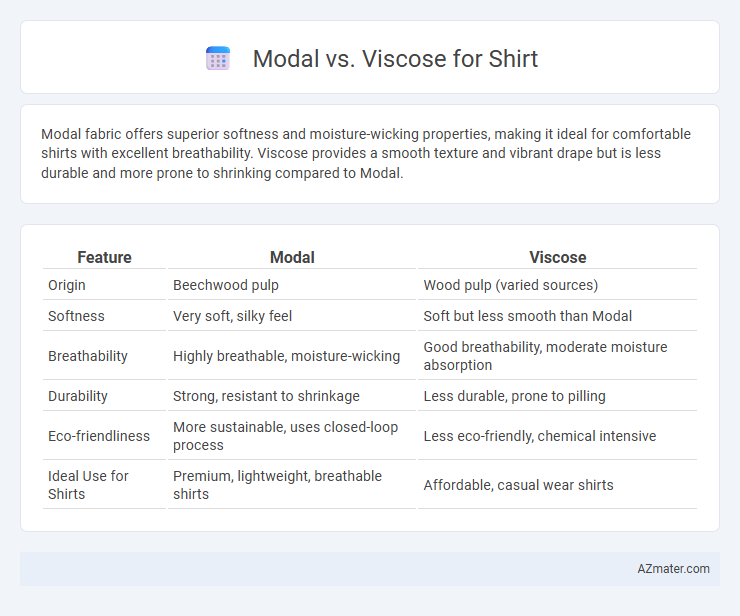Modal fabric offers superior softness and moisture-wicking properties, making it ideal for comfortable shirts with excellent breathability. Viscose provides a smooth texture and vibrant drape but is less durable and more prone to shrinking compared to Modal.
Table of Comparison
| Feature | Modal | Viscose |
|---|---|---|
| Origin | Beechwood pulp | Wood pulp (varied sources) |
| Softness | Very soft, silky feel | Soft but less smooth than Modal |
| Breathability | Highly breathable, moisture-wicking | Good breathability, moderate moisture absorption |
| Durability | Strong, resistant to shrinkage | Less durable, prone to pilling |
| Eco-friendliness | More sustainable, uses closed-loop process | Less eco-friendly, chemical intensive |
| Ideal Use for Shirts | Premium, lightweight, breathable shirts | Affordable, casual wear shirts |
Introduction to Modal and Viscose Fabrics
Modal fabric, derived from beech tree pulp, offers exceptional softness, breathability, and moisture-wicking properties, making it ideal for comfortable and lightweight shirts. Viscose, a semi-synthetic fiber made from wood cellulose, provides a smooth texture and excellent drape, enhancing the aesthetic appeal and comfort of shirts. Both fabrics are prized for their ability to blend natural fiber qualities with enhanced durability and sheen, catering to versatile fashion and comfort needs.
Origins and Manufacturing Processes
Modal fabric originates from beech tree pulp, processed through a chemically intensive method involving cellulose extraction and spinning into fibers, known for its smooth texture and durability. Viscose, a type of rayon, is derived from wood cellulose, primarily from eucalyptus, pine, or bamboo, using a more complex wet-spinning process that dissolves cellulose into a viscous solution before fiber formation. Both Modal and Viscose undergo chemical treatments to convert natural cellulose into versatile textiles, but Modal typically features a more eco-friendly production with higher tensile strength and better moisture absorption.
Key Differences in Fiber Composition
Modal fabric is made from beech tree pulp, a type of semi-synthetic cellulose fiber known for its softness and high moisture absorption, whereas viscose is derived from wood pulp of various sources including bamboo, eucalyptus, and pine. Modal fibers undergo a more refined and environmentally friendly manufacturing process compared to viscose, resulting in better durability and resistance to shrinkage. The key difference lies in fiber structure; modal fibers are stronger and have a smoother finish, making garments like shirts more resistant to wear and maintaining shape better than those made from viscose.
Softness and Comfort Comparison
Modal fabric boasts exceptional softness due to its finer, smoother fibers compared to viscose, making it more gentle against the skin for shirts. Viscose, while also soft, tends to be slightly less durable and can feel less breathable, which may affect overall comfort during extended wear. Shirts made from modal offer superior moisture-wicking properties and stretchability, enhancing comfort in various climates compared to viscose alternatives.
Breathability and Moisture Absorption
Modal fabric excels in breathability due to its natural cellulose fibers, allowing superior air circulation that keeps the wearer cool and comfortable. Viscose, while also breathable, tends to absorb moisture more slowly, making it less efficient at wicking sweat compared to Modal. Modal's enhanced moisture absorption and quick-dry properties make it a preferred choice for shirts designed for active or warm-weather wear.
Durability and Longevity
Modal fabric offers superior durability compared to viscose due to its higher wet strength and resistance to pilling, making it ideal for shirts subjected to frequent washing. Viscose, while soft and breathable, tends to weaken when wet, which can reduce the longevity of a shirt over time. Choosing modal enhances the lifespan of a shirt by maintaining fabric integrity and appearance through extended use.
Environmental Impact and Sustainability
Modal fabric, derived from sustainably harvested beech trees, offers a more eco-friendly alternative to viscose by utilizing closed-loop production processes that reduce chemical waste and water consumption. Viscose, often produced from less sustainably sourced wood pulp, typically involves higher levels of toxic chemicals and water pollution, posing greater environmental hazards. Choosing modal over viscose for shirts supports lower carbon emissions, reduced deforestation, and overall enhanced sustainability in textile manufacturing.
Care and Maintenance Requirements
Modal shirts require gentle washing in cold water to maintain softness and prevent shrinkage, and they dry quickly, reducing the risk of mildew. Viscose shirts need delicate handling with cold water wash and air drying to avoid fabric weakening and shape distortion due to moisture sensitivity. Both fabrics benefit from avoiding bleach and high heat during ironing, with modal generally offering slightly easier maintenance due to higher durability in wet conditions.
Cost Comparison: Modal vs Viscose Shirts
Modal shirts generally cost more than viscose shirts due to the higher quality and durability of modal fibers, which are made from beech tree pulp through a more sustainable and labor-intensive process. Viscose shirts, while cheaper, tend to be less durable and prone to shrinkage and wear, which can result in higher replacement costs over time. Manufacturers price modal shirts higher to reflect their longer lifespan and better moisture-wicking properties compared to viscose alternatives.
Which Fabric is Best for Shirts?
Modal fabric offers exceptional softness, breathability, and moisture-wicking properties, making it ideal for comfortable, lightweight shirts that resist shrinkage and maintain vibrancy. Viscose provides a silky texture and excellent drape but tends to absorb moisture and wrinkle more easily, requiring careful maintenance. Modal's durability and eco-friendly production often make it the preferred choice for high-quality, long-lasting shirts.

Infographic: Modal vs Viscose for Shirt
 azmater.com
azmater.com